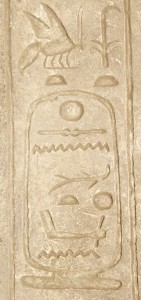 In February of this year, a team of archaeologists from France’s Centre National de la Recherche Scientifique (CNRS) discovered the limestone lintel and door jamb of a 17th Dynasty (ca. 1634 – 1543 B.C.) administrative structure in Luxor’s Karnak temple complex. Hieroglyphics engraved on the doorway marked it as dedicated to the deity Amun-Re. They also contain the cartouche of the pharaoh who ordered the construction: Senakht-en-Re.
In February of this year, a team of archaeologists from France’s Centre National de la Recherche Scientifique (CNRS) discovered the limestone lintel and door jamb of a 17th Dynasty (ca. 1634 – 1543 B.C.) administrative structure in Luxor’s Karnak temple complex. Hieroglyphics engraved on the doorway marked it as dedicated to the deity Amun-Re. They also contain the cartouche of the pharaoh who ordered the construction: Senakht-en-Re.
Accompanying his name are the three main titles given Egyptian pharaohs — Horus, King of Upper and Lower Egypt, Son of Ra — which leave no doubt that the Senakht-en-Re name belongs to a king. The cartouche and titles, carved during his lifetime, prove that he existed and rewrites the chronology of the period.
Little is known about the 17th Dynasty. At the time Egypt was fragmented, with Hyksos kingdoms in the north and center of the country and native Theban pharaohs in Upper Egypt. We don’t even have a definitive list of every king who ruled during the period. Senakht-en-Re’s cartouche is a particularly notable discovery because it’s the first time a contemporary artifact bearing his name has ever been discovered.
He is mentioned in documentary evidence. Scribes writing during the 18th and 19th Dynasties, two centuries after his reign, describe Senakht-en-Re as the ancestor of the New Kingdom pharaohs who kicked out the Hyksos and presided over Egypt’s golden age of prosperity and military success. Egyptologists didn’t put much stock in the accuracy of these statements since they were written long after Senakht-en-Re’s supposed reign and since they served as dynastic propaganda, a way to connect the current rulers with past ones.
The name alone is a major discovery, but the rest of the engraving also provides an interesting glimpse into 17th Dynasty trade. The hieroglyphics say the pharaoh had the door built from limestone blocks quarried at ancient Tora, south of Cairo. Tora was a Hyksos territory at that time, so Senakht-en-Re, a Theban king, was doing business with the Hyksos.
The CNRS team intends to continue excavations in the area. They’ve been digging in the temple of Ptah area, on the north side of the temple of Amun-Re, since 2008. The ultimate aim is restoration for public viewing, but meanwhile they’ve been doing routine study to enhance our understanding of the epigraphic, architectural and archaeological record of the area. They discovered massive mud brick walls — evidence of earlier temples built on the site — and a few ceramic specimens from the late 17th, early 18th Dynasty.
Egyptian Minister of State for Antiquities Mohamed Ibrahim has asked the team to keep excavating the doorway area in the hope that more 17th Dynasty remains will be found to illuminate the history of the period.